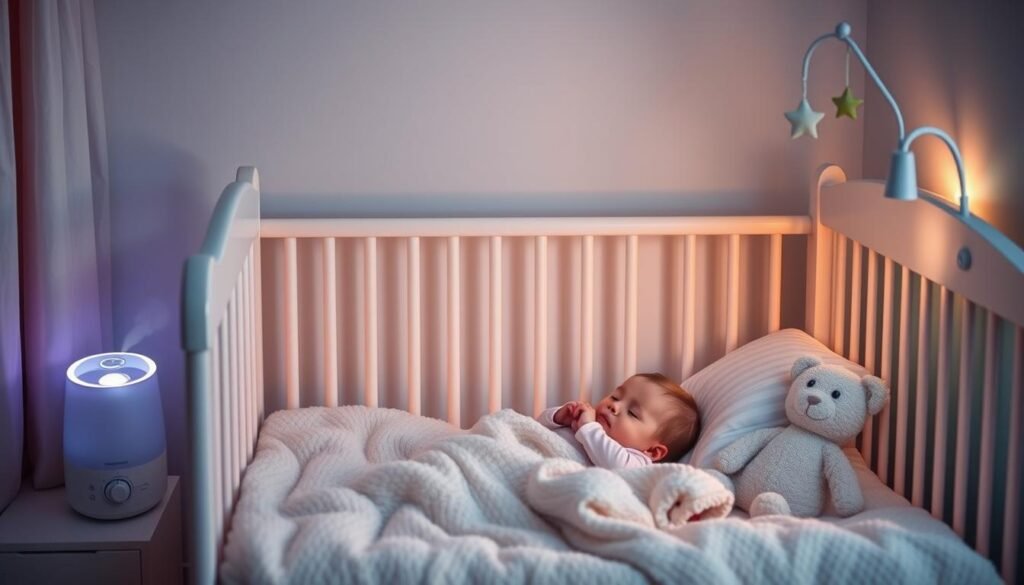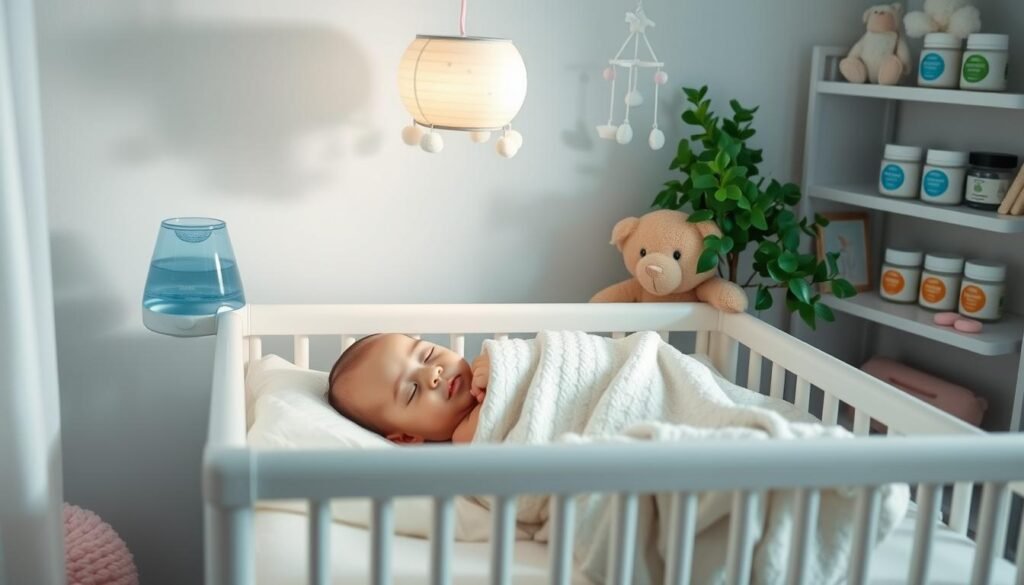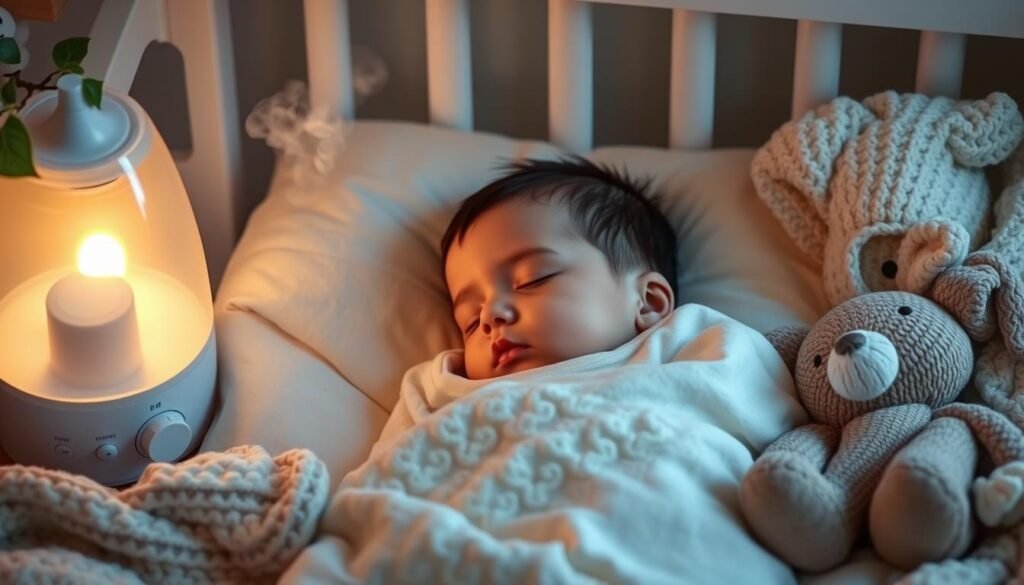As a parent, it’s tough to see my baby struggle with a stuffy nose, especially at bedtime. Babies can only breathe through their nose for the first 12 months. So, it’s key to help them clear their nasal passages when they’re congested. To help my baby sleep better, I use natural remedies and follow safe sleep practices.
I’ve learned that knowing how to help a baby sleep with a stuffy nose is vital. It starts with figuring out why their nose is stuffy. Most babies get 6-10 colds a year, mainly from viral illnesses. By using baby stuffy nose sleep tips, like a consistent bedtime routine, I can help my baby sleep better and avoid complications.
Exploring different approaches, including natural remedies, helps my baby breathe easier and sleep better. It’s important to watch for dehydration signs in congested babies and seek medical help if congestion lasts over two weeks. With the right strategies and sleep tips, I can help my baby overcome a stuffy nose and get the restful sleep they need to thrive.
Understanding Why Babies Struggle with Stuffy Noses at Night
Seeing your baby with a stuffy nose at night can be tough. It’s important to know why this happens. Increased snot and congestion can be due to viruses, allergies, or dry air.
Babies in dry or high-altitude places often get congestion. This can mess with their sleep and health.
For baby congestion sleep solutions, think about what your baby needs. Since they breathe only through their noses for the first year, any blockage is a big problem. A baby nasal congestion night routine is key for their comfort and safety. Knowing the reasons for congestion and acting early can help your baby breathe better and sleep well.
- Viral infections, such as the common cold or flu
- Allergies to indoor or outdoor allergens
- Dry air, which can dry out your baby’s nasal passages
By understanding these causes and taking action, you can help your baby sleep better. Next, we’ll look at important safety tips for treating your baby’s stuffy nose.
Essential Safety Tips Before Starting Any Treatment
As a parent, keeping your baby safe is key, especially when they have a stuffy nose. Before looking into infant stuffy nose sleep aids, make sure their sleep area is safe. Place your baby on their back on a firm, flat surface, away from dangers. The Consumer Product Safety Commission (CPSC) has banned inclined sleepers because they’re not safe.
To help your baby breathe better at night, dress them in warm, breathable clothes. This keeps them cozy without blankets. Also, make sure your baby drinks enough water to thin out mucus. Saline drops made with sterile water and salt can help clear their nose before feeding or naps.
- Always place your baby on their back to sleep
- Use a firm, flat sleep surface
- Keep the sleep environment free from hazards
- Dress your baby in warm, breathable layers
- Ensure your baby stays hydrated
By following these safety tips, you can make a safe and comfy sleep space for your baby. This helps them sleep better and breathe easier, promoting healthy sleep habits.
How to Help a Baby Sleep with a Stuffy Nose: Immediate Solutions
When a baby has a stuffy nose, it’s hard for them to sleep. As a parent, finding ways to help is crucial. One effective method is using gentle suction to clear the nose. This can be done with a bulb syringe or nasal aspirator.
Using saline drops or sprays can also help. They moisturize the nose and loosen mucus. Adding steam therapy, like a humidifier, can make breathing easier and help them sleep better.
Gentle Suction Techniques
Gentle suction is a safe way to clear a baby’s nose. Use a bulb syringe or nasal aspirator to remove mucus. It’s important to be gentle to avoid hurting the baby.
Saline Drops and Sprays
Saline drops and sprays are great for a stuffy nose. They moisturize the nose and loosen mucus. Using them with suction and steam can help a baby breathe and sleep better.
Steam Therapy Methods
Steam therapy can ease congestion and help a baby sleep. Sitting in a steamy bathroom or using a humidifier adds moisture. This loosens mucus and reduces inflammation. Combining steam with suction and saline can help a baby sleep soundly.
Creating the Ideal Sleep Environment for Congested Babies
To help a baby with a stuffy nose sleep better, create a comfy and safe sleep space. Make sure the room is dark, quiet, and cool. Use blackout curtains or shades for a dark room. For quiet, reduce noise or use white noise machines.
A cool room is key, with a temperature of 68-72°F (20-22°C) as the AAP suggests. This helps reduce congestion and improves sleep. Also, a humidifier adds moisture, easing congestion and helping the baby breathe better.
- Use a firm, flat mattress and a tight-fitting sheet to lower SIDS risk.
- Keep the room well-ventilated to prevent respiratory infections.
- Avoid overheating to lower SIDS risk.
By following these tips, parents can make a sleep space that’s comfy and safe for their congested baby. Simple steps can greatly improve a baby’s health and well-being.
| Sleep Environment Tips | Benefits |
|---|---|
| Dark room | Promotes better sleep and reduces congestion |
| Quiet room | Reduces noise levels and promotes relaxation |
| Cool room | Reduces congestion and promotes better sleep |
The Power of Elevation: Safe Ways to Raise Baby’s Head
As a parent, you want to help your baby breathe better when they have a stuffy nose. Elevating their head while they sleep is a good way to do this. It works well with other natural remedies for baby with stuffy nose like saline drops or steam therapy. Elevation is a simple yet effective baby stuffy nose sleep tip to try.
Experts say it’s important to use safe ways to elevate a baby’s head. This can be done through
Crib Mattress Positioning
or other methods. For instance, SNOO Leg Lifters can safely raise a baby’s head by 2.5 degrees. This helps prevent babies from sleeping in ways that might block their airways.
Using SNOO Leg Lifters has several benefits:
- They are slip-resistant and secure
- Designed for cribs to prevent accidents and imbalance
- Prevent babies from sleeping in positions that may restrict their airways
It’s important to avoid traditional crib risers because they are not safe. They lack the specific design for cribs, which can lead to accidents and imbalance.
There are other ways to help your baby sleep better with a stuffy nose. By using these methods with natural remedies for baby with stuffy nose and following baby stuffy nose sleep tips, you can help your baby breathe easier and sleep better.
| Method | Benefits |
|---|---|
| SNOO Leg Lifters | Safe elevation, slip-resistant, and secure design |
| Crib Mattress Positioning | Helps prevent babies from sleeping in positions that may restrict their airways |
Natural Remedies That Actually Work
When your baby has a stuffy nose, natural remedies can be a big help. Using a humidifier is one of the best ways to clear out congestion. It adds moisture to the air, making it easier to breathe. Around 80% of parents use cool-mist humidifiers in their child’s room for this reason.
Steam therapy is another effective method. You can sit in a steamy bathroom with your baby or use a steam inhaler. This helps loosen mucus and makes breathing easier.
Saline drops are also great for loosening mucus and reducing congestion. A warm bath before bed can relax your baby and help them sleep better. Some parents find that honey soothes coughs and promotes sleep. But, always check with a pediatrician before trying new treatments, especially if your baby has allergies.
Here are some more natural remedies for baby congestion sleep solutions:
- Using a nasal aspirator to remove mucus and reduce congestion
- Offering plenty of fluids, such as breast milk or formula, to help thin out mucus
- Creating a sleep-conducive environment, such as keeping the room cool and dark
- Avoiding over-the-counter medications, which can have negative side effects and interact with other medications
| Remedy | Effectiveness |
|---|---|
| Humidifier | 80% of parents report success |
| Steam therapy | Helps to loosen mucus and reduce congestion |
| Saline drops | Loosens mucus and reduces congestion |
By trying these natural remedies and consulting with your pediatrician, you can help your baby sleep better. Always put your baby’s health and safety first. If you have any concerns or questions, don’t hesitate to reach out to a medical professional.
Humidification Strategies for Better Sleep
Seeing your baby with a stuffy nose at bedtime can be tough. Using humidifiers can help. They add moisture to the air, making it easier for your baby to breathe. This makes them a key tool for helping your baby sleep better.
When picking a humidifier, think about the room size and what you need. There are cool mist and warm mist humidifiers. Cool mist ones are safer for babies because they don’t burn.
Optimal Humidity Levels for Babies
The best humidity for babies is 30-50%. This helps with congestion without making the air too wet. It’s important to check the humidity in your baby’s room to keep it right.
Maintaining Your Humidifier
To keep your humidifier working well, you need to maintain it. Clean it often and change the filter when needed. These steps help your baby breathe better at night and sleep comfortably.
| Humidifier Type | Benefits | Considerations |
|---|---|---|
| Cool Mist | Safer for babies, easy to clean | May not be as effective in very dry environments |
| Warm Mist | Can be more effective in very dry environments | Poses a burn risk if not used carefully |
Pre-Bedtime Routine Adjustments for Congested Babies
To soothe baby stuffy nose for sleep, changing the pre-bedtime routine is key. A regular bedtime routine tells the baby it’s time to sleep, even with a stuffy nose. This can include a warm bath, reading, or singing to help them relax.
Adding infant congested sleep remedies to the bedtime routine can help. Using saline drops or a nasal aspirator before bed can clear the baby’s nose. Also, a comfy room temperature and a humidifier can loosen mucus, making sleep easier.
Here are some tips to adjust the pre-bedtime routine for a congested baby:
- Keep the room cool and comfortable
- Use a humidifier to add moisture to the air
- Use saline drops or a nasal aspirator to clear out the baby’s nasal passages
- Avoid over-the-counter decongestants or cough syrups, as they are not recommended for babies under two years old

By adjusting the pre-bedtime routine, parents can help their congested baby sleep better. Always put the baby’s comfort and safety first. If the congestion doesn’t get better or gets worse, talk to a pediatrician.
When to Call the Doctor About Nighttime Congestion
As a parent, knowing when to call the doctor is key. Natural remedies for baby with stuffy nose can help, but some cases need a doctor’s care. If your baby seems distressed or has trouble breathing, it’s time to call the doctor.
Look out for red flags like fever over 100.4°F in babies under 3 months. Also, watch for symptoms lasting more than 10 days or signs of dehydration. Yellow or green eye discharge is another warning sign that needs medical attention.
Red Flags to Watch For
- Infants under 3 months with a fever over 100.4°F
- Symptoms lasting over 10 days
- Signs of dehydration
- Yellow or green discharge from the eyes
Emergency Symptoms
In serious cases, your baby might show emergency signs. These include a lot of wheezing or trouble breathing. If you see these, get help right away. It’s always safer to be cautious with your baby’s health.
By using baby stuffy nose sleep tips and getting medical help when needed, your baby can breathe better and sleep well.
| Age | Fever Threshold |
|---|---|
| 0-3 months | >100.4°F |
| 3-24 months | >102°F |
| over 2 years | >104°F |
Preventive Measures for Future Congestion
To lower the chance of future congestion, taking steps early is key. As a parent, I’ve found that keeping a clean, healthy space for my baby is essential. This means cleaning surfaces often, washing hands a lot, and staying away from cigarette smoke. These actions help cut down the risk of my baby getting congestion.
Keeping the air moist is another important step. Dry air can make congestion worse. So, using a humidifier helps keep the air moist and eases congestion. Especially in the dry winter, a humidifier has been a big help for my baby. It’s a great baby congestion sleep solution when it comes to how to help a baby sleep with a stuffy nose.
Environmental Allergen Control
It’s also crucial to control environmental allergens to prevent congestion. This means reducing dust, pollen, and pet dander. Here are some ways to do this:
- Using allergen-proof bedding and mattress covers
- Regularly vacuuming and dusting surfaces
- Keeping pets out of the bedroom
Seasonal Preparation Tips

Being ready for seasonal changes can also help prevent congestion. In winter, using a humidifier and keeping the home warm can help. In spring and summer, avoiding pollen and other allergens can also help. By taking these steps, I can help my baby breathe better and lower the risk of future congestion.
| Season | Preventive Measures |
|---|---|
| Winter | Use a humidifier, keep the home warm |
| Spring/Summer | Reduce exposure to pollen and other allergens |
Common Mistakes Parents Make When Treating Stuffy Noses
Seeing your baby struggle with a stuffy nose at bedtime can be tough. It’s natural to want to help them breathe better. But, some common mistakes can make things worse. Using medicines without a doctor’s okay is a big mistake, as they can harm babies.
Another error is using inclined sleepers. These can raise the risk of SIDS and other sleep dangers. The American Academy of Pediatrics (AAP) says babies should sleep on their backs to lower SIDS risk. The Consumer Product Safety Commission also warns against sleeping on an incline over 10 degrees.
To help your baby breathe better at night, try infant stuffy nose sleep aids. Saline nasal drops or a humidifier in their room can help.
Some key mistakes to avoid when treating stuffy noses include:
- Using over-the-counter medications without consulting a doctor
- Using inclined sleepers or elevating the head of the bed more than 10 degrees
- Not keeping the baby hydrated, especially if feeding becomes difficult due to nasal congestion
Knowing these mistakes and avoiding them can help your baby breathe and sleep better. It’s crucial to use safe and effective treatments. Using infant stuffy nose sleep aids is a good way to help your baby at bedtime.
| Mistake | Safe Alternative |
|---|---|
| Using over-the-counter medications | Consulting a doctor for recommended treatments |
| Using inclined sleepers | Using a flat, firm mattress and keeping the sleep environment safe |
| Not keeping the baby hydrated | Offering frequent feedings and monitoring for signs of dehydration |
Your Path to Peaceful Nights: Taking Action with Confidence
As a parent, it can be tough to help your baby sleep with a stuffy nose. But, with the right steps, you can overcome this challenge. You’re not alone; many families have faced this and found solutions.
Try the best ways to help baby with stuffy nose sleep. Use gentle suction, saline drops, and create a cozy sleep space. Soon, you’ll find what works best for your family.
Start this journey with confidence. You have the tools and knowledge to help your baby. Your baby’s comfort is worth the effort. Soon, you’ll enjoy many peaceful nights together.


